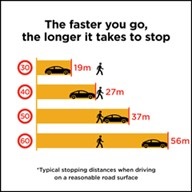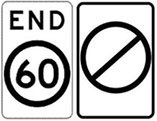Driving too fast is the single biggest contributor to death and injury on NSW roads. Each year, speeding contributes to about 41% of road fatalities and 24% of serious injuries. Almost 135 lives are lost and 1141 people are seriously injured
To reduce the increased risk of crashes, motorists need to adjust their driving behaviour to suit the road and prevailing weather conditions.

Speeding is travelling at a speed greater than the speed limit. You can also be speeding if you are travelling too fast for the driving conditions. If road conditions are less than ideal, for example rain, heavy traffic, night time etc, you may be speeding even if you’re driving at or below the posted speed limit.
You may think that driving slightly over the speed limit is still safe however a small increase in speed can make a big difference in the seriousness of a crash.

- In a crash between a car and a pedestrian, there is a 10 per cent risk that a pedestrian will be killed at 30 km/h, 40 per cent risk at 40 km/h, and a 90 per cent risk at 50 km/h.
- In a head-on crash between two vehicles, there is a 5 per cent risk that a driver or passenger will be killed at 60 km/h, 10 per cent risk at 70 km/h, and an 80 per cent risk at 90 km/h.
- In a side-impact crash with another vehicle, there is a 10 per cent risk that a driver or passenger will be killed at 50 km/h, a 40 per cent risk at 60 km/h, and an 80 per cent risk at 70 km/h.
Aside from health and safety consequences, driving above the speed limit can also result in traffic offences and penalties.
The faster you go, the longer it takes to stop. A typical stopping distance when travelling at 30 km/h on a reasonable road surface is 19 metres, while at the slightly faster speed of 40 km/h, the stopping distance increases to 27 metres.
If you are driving at 50 km/h, it will take you about 37 metres to stop, but at 60 km/h that distance increases significantly to 56 metres. Even a small difference in vehicle speed can make a large difference to the likelihood of death or serious injury. If a car hits a pedestrian at 50 km/h, the impact is twice as likely to kill the pedestrian than if the car had been travelling at 40 km/h.

In addition to speed, other factors affect stopping distances, including:
- Distractions, fatigue or dim lighting, where drivers take longer to react
- Wet roads or worn tyres, which can lengthen braking distances.
To reduce the risk of a crash, drivers should stay under the speed limit and drive to the conditions, such as slowing down in wet weather or poor visibility.
A small increase in speed can make a big difference to the seriousness of a crash. Any extra speed means extra impact force – and the human body can only tolerate limited physical forces before death or serious injury occurs.
Advisory speed signs are not legal speed limits but are used to inform and warn motorists of upcoming changes in road alignment such as curves, bends, humps and dips and guide driver behaviour. The signs indicate a recommended maximum speed in good driving conditions for the average car to help motorists safely negotiate these road features.

Some roads do not have speed signs, such as unsealed roads and roads in remote areas. On these roads an end speed limit or speed de-restriction sign indicates you are entering an area without speed signs. In these areas the default speed limits apply, and you must drive to the conditions.
